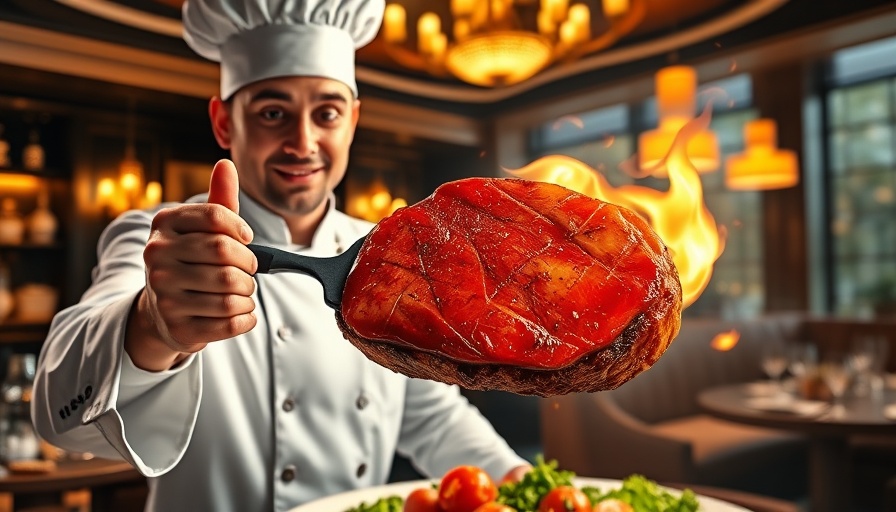
Understanding Food Cost Percentages to Boost Profitability
Restaurant owners and managers, navigating the fine line between cost and profit can often feel overwhelming. However, mastering food cost management is pivotal if you want to ensure the sustainability and growth of your restaurant. The key rules for managing food costs for appetizers, entrées, and beverages can set you on the right track to enhancing profitability while maintaining customer satisfaction.
In 'Master These Food Cost Rules To Save Your Restaurant Money,' insights into managing food costs unveil strategies crucial for restaurant profitability.
Setting Standards: Appetizer Food Costs
When it comes to appetizers, aiming for an average food cost of around 10% is an excellent benchmark. However, you should never allow your food cost to exceed 20%. By keeping these costs in check, you can utilize cost-effective suppliers and take control of portion sizes. The challenge is to create exciting, high-quality appetizers that entice customers without overstretching your budget. Nevertheless, it is essential to remind yourself that food costs are your guiding light—steady experimentation and creative menu developments must align within this structure for optimum efficiency.
Entrée Food Cost Strategies
Shifting our focus, entrées require a slightly different approach. Aiming for 25% in average food cost while managing to cap it at 40% is a smart goal for most restaurants. Of course, exceptional items, like a premium steak, may incur higher costs—up to 50%. These should, however, be the outliers in your menu. This strategy empowers you to introduce high-quality ingredients on special occasions, attracting discerning diners while ensuring that your regular offerings remain profitable and enticing.
Smart Beverage Costing Techniques
Beverages often represent an underutilized revenue stream in restaurants. Targeting a 15% average cost should be your primary goal. Making beverages in-house can significantly drive down costs, allowing you to offer premium-priced options without sacrificing quality. This approach encourages diners to order drinks with their meals, enhancing overall dining experiences and ultimately encouraging customers to return.
Implementing a 3x Pricing Strategy for Entrees
To maintain profitability, employing a 3x pricing strategy on entrées is highly recommended. This means that for every dollar spent on food, you should ideally charge three dollars. This rule creates a robust financial framework that helps shield restaurants from market fluctuations. Furthermore, introducing a few items that can be priced at 10x the food cost can act as a significant profit booster. Think of signature dishes that can draw in diners and enhance your revenue. Establishing a strong narrative around these dishes can create a memorable dining experience.
Maximizing Profit: The 10x Pricing Model
Introducing high-margin dishes—those 10x pricing ideas—can't be understated. These dishes should contain unique ingredients or be tied to a particular dining experience, perhaps involving exclusive cooking techniques. They not only reduce the overall food costs but also elevate the dining experience, making customers feel they are indulging in something special. In the competitive restaurant landscape, where every decision impacts your bottom line, showcasing high-value items and their stories can vastly enhance customer engagement.
Promoting Your Restaurant: Effective Marketing and Promotions
Now that you understand your food costs, let’s consider how you can effectively promote these dishes and, by extension, your restaurant overall. Building a strong restaurant marketing strategy tailored to your target audience is essential. Share photos and videos of your delicious, high-margin dishes across social media platforms—consider creating a restaurant marketing video that encapsulates the ambiance and offerings of your restaurant.
Engaging your customers via promotions can also create excitement and drive traffic. Using themed nights, seasonal menu items, or community events can deepen customer loyalty. In-n-out's success emphasizes the power of branding and customer experience in the modern dining world. Implementing thoughtful, engaging marketing strategies is essential for positioning your restaurant within a competitive market.
Conclusion: The Importance of Understanding Food Costs
Mastering food cost rules is not merely a financial exercise; it is essential for ensuring the long-term success of your restaurant. By establishing clear guidelines for appetizers, entrées, and beverages, employing effective pricing strategies, and implementing robust marketing techniques, you set your restaurant on the path to profitability. Don’t forget—keep experimenting and innovating, as staying relevant in the food industry requires consistent evolution. Dive into your restaurant management and see how each of these strategies can be tailored to fit your unique brand and customer base.
If you're ready to make impactful changes to your restaurant's profitability and marketing strategies, start today by analyzing your food costs. Your bottom line will thank you!
 Add Row
Add Row  Add
Add 




 Add Row
Add Row  Add
Add 

Write A Comment